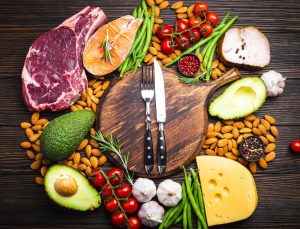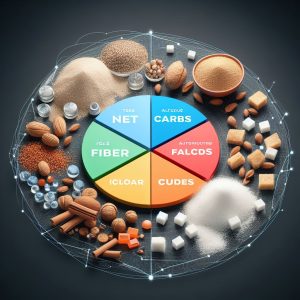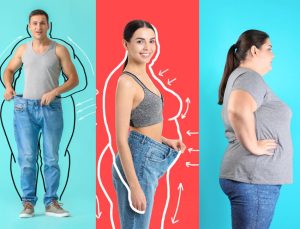The ketogenic or “keto” diet has become an incredibly popular way to lose weight and improve health in recent years. It focuses on cutting carbs drastically while increasing fat intake. This puts your body into a metabolic state called ketosis.
But just how low in carbs do you need to go to achieve ketosis? And what’s the ideal daily carb intake to see results on keto without negatively impacting your health?
This article will cover the science behind carb restriction, optimal carb levels for keto, which carbs to limit, and tips for staying in ketosis.
What is Ketosis?
Ketosis refers to a natural metabolic state where the liver produces ketone bodies from fatty acids for use as energy, instead of getting energy primarily from carbohydrates (glucose).
This occurs when carb intake is extremely low, usually below 50g per day. It takes about 1-3 days of very low carb eating for the body to shift into ketosis.
In ketosis, the body breaks down both body fat and dietary fat into ketones, which become the main fuel source for both the brain and body.
Ketosis has been shown to promote weight loss, lower blood sugar, and may provide neuroprotective effects for conditions like epilepsy. However it also causes side effects in some people as the body adapts, known as “keto flu.”

Why Restrict Carbs on Keto?
On a normal higher carb diet, the body breaks down carbohydrates into glucose and this becomes the preferred energy source. Excess carbs are stored as glycogen in the muscles and liver.
By contrast, very low carb diets force the body to find alternate fuel sources since dietary glucose is minimal. So the liver starts producing ketones from stored or dietary fat instead.
Limiting number of carbs to 20-50g or less per day on keto depletes glycogen stores. This forces ketone production and ketosis within a few days.
Restricting carbohydrates also decreases insulin levels. Lower insulin seems to increase fat breakdown and promote feelings of fullness.[1]
How Many Carbs for Ketosis?
To get into a metabolic state of ketosis, research shows that most people need to keep net carbs under 50g daily. However, 20-30g or less is recommended, especially to see the full benefits.
Ketosis thresholds can vary based on the individual. Some may need to go even lower to get their body into fat burning mode. The general recommendations are:
- Start with a limit of 20g net carbs daily
- After 2-3 weeks, increase to 30g if weight loss stalls
- Stay under 50g total carbs daily
- Lower carb intake again if weight loss plateaus
Tracking ketones and symptoms when increasing carbs can help you identify your personal carb tolerance for ketosis.
What are Net Carbs?
To follow keto, it’s important to distinguish between total carbs and net carbs:
- Total carbs = grams of carbs in a food
- Net carbs = Total carbs – Fiber – Sugar alcohols
- Fiber and certain sugar alcohols are excluded because they don’t raise blood sugar
Keeping net carbs low ensures ketosis, as fiber content is excluded. That’s why high fiber vegetables are encouraged on keto despite having carbs.
When checking carb counts, look at net carbs rather than total carbs for a more accurate representation of a food’s effect on ketosis.

What to Limit for Keto?
Cutting out all high carb foods forces your body to look for alternate fuel sources and enter ketosis.
Foods to limit or avoid on keto include:
- Grains: Bread, cereal, pasta, rice, etc.
- Starchy vegetables: Potatoes, sweet potatoes, corn, peas, etc.
- Legumes: Beans, lentils, peanuts.
- Fruit: Especially high sugar fruits like bananas, apples, grapes.
- Sugary foods: Soda, juice, candy, ice cream, baked goods
- Processed snacks: Chips, pretzels, crackers
- Alcohol: Especially beer, mixed drinks, wine coolers
- High carb condiments: Barbecue sauce, sweet chili sauce, honey mustard.
Meat, Dairy and Vegetables on Keto
While most carbs need to be restricted, there are some you can eat in moderation on keto:
Meats: Fatty cuts of beef, pork, lamb, poultry (with skin), eggs, bacon.
Fish: Salmon, tuna, trout, mackerel, sardines.
Dairy: Full-fat milk, cheese, unsweetened yogurt, heavy cream.
Low Carb Vegetables: Leafy greens, broccoli, cauliflower, peppers, zucchini, onions, tomatoes.
Nuts and seeds: Almonds, walnuts, sunflower seeds, chia seeds.
Natural fats: Olive oil, coconut oil, avocado oil, butter.
Focus your meals around these proteins, fats and non-starchy vegetables while limiting carbs.

Should You Go Below 20g Carbs?
Some keto dieters aim for zero carb or less than 15g net carbs daily. This very low carb approach may get you into ketosis faster and result in quicker weight loss initially.
However, restricting carbs too severely long-term may not be beneficial and can increase potential deficiencies. Getting some carbs from high fiber vegetables, dairy and nuts/seeds is advised for micronutrients.
Unless you are using keto to treat epilepsy or have stalled weight loss, less than 20g total carbs daily is likely not needed. Start with 20-30g and find the level that works for you.
Tips for Reducing Carbs
Here are some tips for painlessly reducing your carb intake to get into ketosis:
- Eliminate obvious carb-heavy foods like sugars, grains, rice, cereals, legumes, starchy vegetables and fruits.
- Limit fruits to 1⁄2 cup berries per day max.
- Use non-starchy veggies generously – leafy greens, peppers, broccoli, etc.
- Choose full-fat, unsweetened dairy instead of low-fat options.
- Drink unsweetened coffee or tea instead of soda, juice or sweetened drinks.
- Focus meals around fatty proteins – eggs, meat, fish, poultry.
- Cook with healthy fats like olive oil, coconut oil, avocado oil.
- Use small portions of nuts and seeds for snacks
- Check labels and calculate net carbs for packaged foods.
- Gradually taper carbs down over a few weeks leading up to keto.
Following these tips starting out can help your body ease into ketosis and adapt to burning fats for fuel through this fat adapted state.
Potential Benefits of Keto
Limiting carbs to induce ketosis may provide these benefits:
Weight Loss
Several studies show low carb ketogenic diets specifically help shed body fat while preserving muscle mass.[2] Higher fat intake and ketone production seem to increase feelings of fullness as well compared to high carb diets.
Reduced Appetite
Keto has been shown to reduce levels of the hunger hormone ghrelin while increasing satiety hormones GLP-1 and peptide YY, leading to less hunger.[3]
Lower Blood Glucose
Ketosis improves insulin resistance, lowers fasting blood sugar levels, and may reduce HbA1c in diabetics more than a low fat diet. [4]
Improved Heart Health
The high-fat keto diet appears to improve triglycerides, cholesterol markers, blood pressure and inflammation markers when carbohydrates are restricted.[5]
Increased Mental Focus
Some evidence suggests cognitive performance, learning, and memory may improve for some following a ketogenic diet due to more stable energy levels.
Is Keto Safe Long-Term?
The long-term safety of ketosis is still unknown since the diet is relatively new in popularity. Potential side effects include:
- Nutrient deficiencies – Without carbs, micronutrient intake can be low long-term leading to deficiencies in vitamins, minerals and phytonutrients over months or years on keto. These can be prevented by eating lots of low carb vegetables.
- Digestive issues – High fat intake combined with low fiber carbs may cause constipation, diarrhea, or indigestion in some people.
- Bad cholesterol – In those predisposed to abnormalities in cholesterol profiles, very high saturated fat intake could potentially increase LDL and raise cardiovascular disease risk.[6]
- Kidney problems – Kidneys help metabolize protein. High protein keto diets may burden kidney function in those with chronic kidney disease. Checking kidney biomarkers is recommended.
- Hypoglycemia – People on diabetes medications that increase insulin levels might experience blood sugar dropping too low with carbs restricted.
- Ketoacidosis – Very rare, but possible for those with type 1 diabetes if ketones build up dangerously high. Ketoacidosis is serious and can be fatal.
Overall, more long-term research is needed on extended ketogenic diets. Periodic carb cycling or “targeted” keto taking breaks from ketosis may be beneficial. Working with a doctor and dietitian can help ensure nutritional adequacy and monitor any potential negative impacts.
Healthy Carbs for Keto
To meet nutritional needs, it is possible to incorporate limited amounts of certain healthy carbohydrate foods. Focus on getting carbs from high fiber, nutrient-dense sources like:
Vegetables: Leafy greens, broccoli, tomatoes, peppers, mushrooms, onions, zucchini, eggplant
Nuts and seeds: Almonds, walnuts, sunflower seeds, pumpkin seeds, chia seeds, flaxseed.
Berries: Raspberries, blackberries, blueberries, strawberries
Dairy: Greek yogurt, cottage cheese, hard cheeses
Legumes: Small portions of lentils, green peas, peanuts, edamame
Aim to get 25-30g net carbs or less only from these healthy sources as part of a well-formulated ketogenic diet to support overall health.
Creating an Individualized Keto Plan
There is no one size fits all approach to keto. The optimum amount of carbs for ketosis varies by individual. You may need to experiment and fine-tune your carb intake to see what works best for you.
Tips for finding your carb “sweet spot” for ketosis:
- Use 20g net carbs per day for first 2-3 weeks
- Increase daily carbs by 5g increments, up to 50g max
- Check weight, ketones, and symptoms each week
- Note carb level that maintains ketosis and promotes continued weight loss
- Adjust your keto carb allowance as needed over time
In general, staying between 20-50g net carbs daily is recommended for ketosis. Consuming high quality, nutrient-dense carbs and getting enough physical activity also helps create a balanced plan that is sustainable.
Signs You’re in Ketosis
Here are some signs your body has entered ketosis:
- Weight loss
- Reduced appetite
- Dry mouth
- Increased thirst and urination as kidneys excrete ketones
- Improved mental clarity and focus
- Increased energy and endurance
- “Fruity” breath
- Urine ketone test strips show positive results
Use these as feedback to adjust your carb intake. If symptoms disappear, reduce carbs. If side effects become bothersome, increase healthy carbs slightly.
Transitioning Off Keto
If you decide to stop keto after losing weight, be mindful of slowly increasing carb portions again without overdoing it.
Tips for getting off keto:
- Gradually increase daily carbs by 5-10g weekly
- Stop checking ketones and weights
- Add fruits, starchy vegetables, beans/legumes
- Be active to allow for higher carb intake
- Watch for weight gain and increased cravings
- Work with a professional to create a balanced diet plan
With a controlled carb reintroduction, you can maintain your weight loss success while feeling satisfied getting back into ketosis if needed.
Considerations for Athletes
Very low carb, high fat ketogenic diets can help endurance athletes burn more fat. However, athletes involved in high intensity training or strength building often do better with some dietary carbohydrates to maximize performance.
Cyclical keto strategies taking 1-2 days a week to carb up around workouts may help boost athletic potential. Working with a sports dietitian can help design an appropriate ketogenic approach tailored for your training demands.
Sustainable Low Carb Eating
Keto can provide rapid results initially. However, very low carb diets are notoriously difficult for most people to follow forever. That’s why many turn to more flexible and less restrictive low carb or “moderately ketogenic” diets long-term.
Research defines a moderate ketogenic diet as containing 50-100g of carbs per day, a level that allows for ketone production without needing to weigh and strictly calculate every meal.[7]
This more relaxed approach focuses on carb quality, gut health, and overall well-being. It provides enough carbs to stay satisfied while keeping insulin levels low enough to encourage fat burning and make weight management seamless.
Key Takeaways
- The keto diet involves restricting net carbs to 20-50g daily to enter ketosis, a fat burning metabolic state.
- Limit high carb foods like grains, legumes, starchy vegetables, and fruits to keep carbs low.
- Base meals around proteins, healthy fats, non-starchy veggies and dairy.
- Benefits of very low carb keto include rapid weight loss, reduced hunger, lower blood glucose, and improved heart health markers. However, long term effects need more research.
- Potential side effects include nutrient deficiencies, digestive issues, hypoglycemia, and bad cholesterol changes from high saturated fat intake. Medical supervision is recommended.
- Monitor your individual carb tolerance for ketosis using symptoms and weight changes as feedback.
- Incorporate limited amounts of “safe starches” like dairy, nuts/seeds, and high fiber carb foods for a more balanced approach if needed.
- Moderately ketogenic diets containing 50-100g carbs may be more sustainable than very low carb keto for health, performance, and longevity.
FAQS
What is a keto diet?
A keto diet, short for a ketogenic diet, is a low-carb, high-fat diet that has been shown to help people lose weight. It involves reducing your carbohydrate intake and replacing it with fats.
How does a keto diet work?
When you consume fewer carbohydrates, your body is forced to burn fat for energy instead of glucose. This state is called ketosis, and it can help you burn fat more efficiently.
How many carbs can eat on the keto diet?
The exact amount of carbs you can have on a keto diet may vary depending on your individual needs and goals. However, most keto dieters aim for fewer than 50 grams of net carbs per day.
What are net carbs?
Net carbs are the number of carbohydrates in a food that your body can actually digest and use for energy. To calculate net carbs, you subtract the grams of fiber from the total grams of carbohydrates.
Can I eat high-carb foods on a keto diet?
No, a keto diet is typically very low in carbohydrates, so it’s important to avoid high-carb foods such as grains, sugars, and starchy vegetables.
What happens if I eat high carb intake on a keto diet?
If you consume too many net carb on a keto diet, it can kick you out of ketosis and make it harder for your body to burn fat for fuel. This can result in weight gain or stalled weight loss.
Can I have cheat days on a keto diet?
Some people choose to have cheat days or occasional high-carb meals while on a keto diet. However, this can slow down your progress and make it more difficult to stay in ketosis.
What are the benefits of a ketogenic diet?
The ketogenic diet has been shown to help with weight loss, improve insulin sensitivity, reduce inflammation, and provide steady energy levels throughout the day.
How long does it take to get into ketosis?
It typically takes 2-7 days of following a strict low-carb diet to enter ketosis. The time can vary depending on individual factors such as metabolism and activity level.
Is a ketogenic diet safe?
A ketogenic diet is generally considered safe for most people, but it’s always a good idea to consult with a healthcare professional before starting any new diet or lifestyle change.
